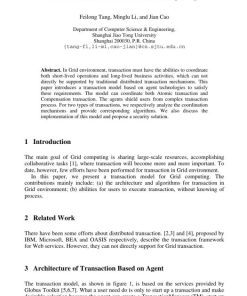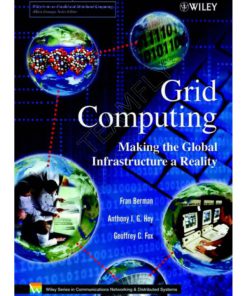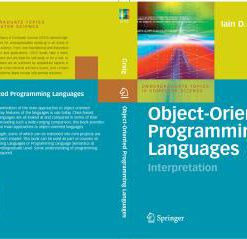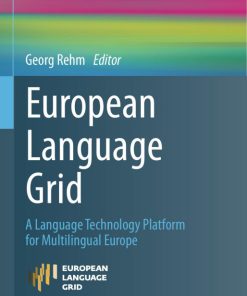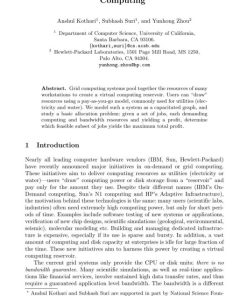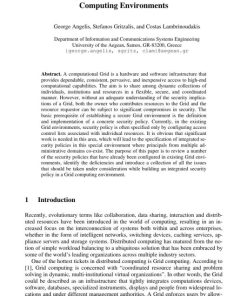Grid Computing 1st Edition by Joshy Joseph, Craig Fellenstein ISBN 0131456601 9780131456600
$50.00 Original price was: $50.00.$25.00Current price is: $25.00.
Authors:By Joshy Joseph, Craig Fellenstein , Series:Computer Science [300] , Author sort:By Joshy Joseph, Craig Fellenstein , Ids:0131456601 , Languages:Languages:eng , Publisher:Prentice Hall PTR , Comments:Comments:Published December 30, 2003, 400 pages.
Grid Computing 1st Edition by Joshy Joseph, Craig Fellenstein – Ebook PDF Instant Download/Delivery. 0131456601, 9780131456600
Full download Grid Computing 1st Edition after payment

Product details:
ISBN 10: 0131456601
ISBN 13: 9780131456600
Author: Joshy Joseph, Craig Fellenstein
According to John Patrick, IBM’s vice-president for Internet strategies, “thenext big thing will be grid computing.”The purpose of this book will be to describe several interesting and uniqueaspects of this exciting new topic. Grid Computing is a type of parallel anddistributed system set-up that enables and encourages the sharing ofgeographically dispersed resources. In many ways, it represents theconvergence of supercomputing and web services. The book highlights manyachievements in this innovative computer science field, and it is intended to beof value to a wide spectrum of readers around the world regardless. IBM israpidly establishing itself as the global leader in the topic of Grid Computing.This book not only address IBM’s leadership progress in the field, but otherglobal enterprise initiatives, specific areas of interests, synergies between manyenterprise partners in this field, and current/future deliveries in the field ofGrid Computing. Today, there is no other book like this one that explains thepromise and IBM’s plans for this important initiative.
Grid Computing 1st Table of contents:
Part I: Introduction to Grid Computing
-
Introduction to Grid Computing
- Defining grid computing and its evolution.
- Key concepts: distributed systems, resource sharing, and virtualization.
- How grid computing differs from traditional computing paradigms.
-
Grid Architectures
- Basic grid architecture models (e.g., centralized, decentralized, hybrid).
- The role of middleware in grid computing.
- Overview of grid service models and architecture patterns.
-
Grid Middleware
- What is grid middleware and its role?
- Types of middleware: communication, security, resource management.
- Popular grid middleware platforms (e.g., Globus, UNICORE, Open Grid Services Architecture).
Part II: Core Technologies and Tools
-
Resource Management and Scheduling
- Techniques for resource discovery, allocation, and scheduling.
- Load balancing and fault tolerance in grid environments.
- Resource management frameworks and tools.
-
Communication Protocols in Grid Computing
- Overview of grid communication models and protocols.
- Data transfer protocols: HTTP, TCP/IP, GridFTP.
- Remote procedure calls (RPC) and messaging systems.
-
Security in Grid Computing
- Security challenges in a distributed grid environment.
- Authentication, authorization, encryption, and privacy in grid systems.
- Grid security standards (e.g., Grid Security Infrastructure, GSI).
-
Grid Computing for High-Performance Computing (HPC)
- The role of grids in HPC and large-scale scientific computing.
- Techniques for optimizing grid performance.
- Case studies in scientific applications (e.g., climate modeling, bioinformatics).
Part III: Grid Computing Applications
-
Scientific Applications of Grid Computing
- Use of grid computing in scientific research: simulations, data analysis, and modeling.
- Applications in physics, biology, astronomy, and engineering.
- Case studies: LHC, SETI@home, and other research initiatives.
-
Grid Computing in Industry
- Industry applications: finance, healthcare, and business.
- Collaborative workflows in engineering and product design.
- Applications in large-scale simulations and manufacturing.
-
Grid Computing in e-Science and e-Health
- Leveraging grids for collaborative scientific research.
- Grid applications in medicine and healthcare.
- Telemedicine, bioinformatics, and large-scale health data analysis.
Part IV: Advanced Topics and Future Directions
- Grid Computing and Cloud Computing
- The relationship between grid computing and cloud computing.
- Hybrid models and integrating grids with cloud platforms.
- The evolution of cloud grids and computing as a service.
- Emerging Technologies in Grid Computing
- The role of grid computing in the context of Big Data and the Internet of Things (IoT).
- Machine learning, AI, and their integration into grid environments.
- Future trends: quantum computing and next-generation grid systems.
- Global Grid Infrastructures
- Building and managing global grid infrastructures.
- Examples of global grids: European Grid Infrastructure (EGI), Open Science Grid (OSG).
- Collaborative and international grid computing projects.
Part V: Case Studies and Real-World Implementations
- Case Study 1: The Globus Grid
- Detailed analysis of the Globus Toolkit for grid computing.
- Key challenges, lessons learned, and use cases from real-world implementations.
- Case Study 2: The SETI@home Project
- The SETI@home distributed computing project and its use of grid computing.
- Volunteer computing and large-scale scientific collaboration.
- Case Study 3: The LHC Grid
- Use of grid computing in the Large Hadron Collider (LHC) experiments.
- Managing vast datasets and distributed computing resources.
People also search for Grid Computing 1st:
grid computing
journal of grid computing
types of grid computing
define grid computing
difference between cluster and grid computing







